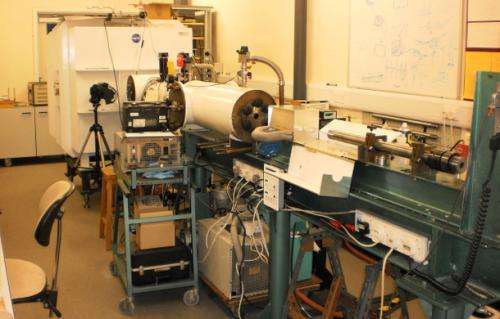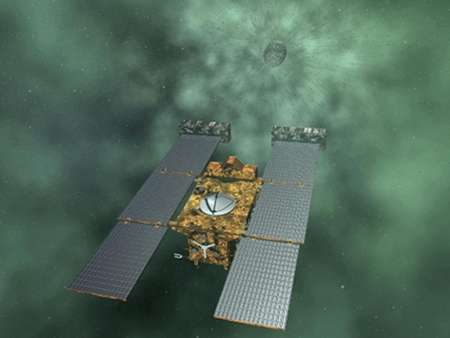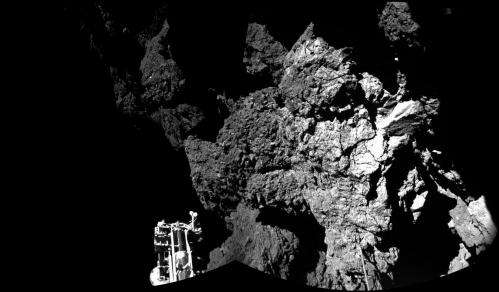Cosmic impacts might help synthesize organic compounds

Bullets of ice shot at high speeds can deposit organic compounds on surfaces they strike. The new findings suggest that comets might, indeed, have helped deliver key ingredients of life to Earth and perhaps elsewhere, researchers say.
The scientists detailed their findings in the June 13 issue of the journal Astrobiology.
Craters on the moon are evidence that the Inner Solar System was prone to giant impacts from asteroids and comets during a tumultuous era, known as the Late Heavy Bombardment, between 4.2 billion to 3.8 billion years ago. Intriguingly, this violent period overlaps with evidence of the earliest life on Earth, suggesting that these impacts may have played a role in the origin of life.
The key building blocks of life on Earth—such as sugars, amino acids and DNA—are carbon-based molecules known as organic compounds. Decades of research have revealed that complex organic compounds are found in space and can be successfully delivered to Earth. For example, scientists have found amino acids in meteorites, and NASA's Stardust mission to the comet 81P/Wild 2 returned samples from the envelope of gas and dust around the comet's heart that revealed the presence of amino acids and other organic materials. These prior studies hint that cometary impacts could deliver vast quantities of organic compounds to Earth, and perhaps other potential abodes of life as well, such as Mars and Jupiter's moon Europa.
An open question is how well complex organic compounds delivered by cosmic impacts actually survive these crashes, which involve destructive factors such as high speeds, extreme pressures and extraordinary heat. A number of experiments have sought to mimic these conditions in the lab, subjecting, for example, amino acids to high temperatures and pressures. These studies found that these conditions, far from harming the organic compounds, might even help synthesize them.
A variety of tests have shot projectiles at targets rich in organic molecules. Researchers have fired steel projectiles at nearly 11,200 mph (18,000 kph) at ices loaded with organic compounds, and have also experimented with shooting projectiles containing organic-rich mudrock, and other organic compounds, at sand and water targets. The research suggested that organic molecules, and even microbes, could survive high-speed impacts.

However, no one had sought to see if organic molecules in frozen projectiles could survive high-speed impacts. Now, scientists have fired such icy bullets at a variety of types of targets in order to mimic the effects of a comet's impact on Earth and other bodies in the Solar System.
"Nature delivers ices to us in high-speed impacts from comets, and it seemed to me we should do the same in our experiments," said lead study author Mark Burchell, a planetary scientist at the University of Kent in England.
Burchell and his colleagues created projectiles made of a frozen mixture containing organic compounds, such as anthracene and stearic acid. The former is found in coal tar, while the latter is often seen in animal and vegetable fats and oils. The projectiles were fired using a gun powered by gas pressure, and the gun was kept refrigerated before use.
Three types of target were used—sand, ice and liquid water—to represent various surfaces found throughout the Solar System. The projectiles were launched at these targets at speeds of roughly 4,475 to 8,950 mph (7,200 to 14,400 kph), the kinds of speeds at which rocks blasted off Earth hit the Moon, or at which meteorites collide with Pluto and other icy bodies in the Outer Solar System.
The scientists found that organic compounds survived well after slamming into all targets.

"Compounds carried in icy bodies can survive impacts and transfer to a target," Burchell said.
In the future, the researchers would like to use organic-rich icy projectiles launched at roughly 33,550 to 44,750 mph (54,000 to 72,000 kph), which are more typical of the higher speeds at which comets strike the Earth or Moon. They can currently fire projectiles at speeds of up to about 13,425 to15,650 mph (21,600 to 25,200 kph); at speeds greater than that, the barrel of the gun can break.
Future research could also focus on creating icy projectiles that better match the composition of comets. For instance, the European Space Agency's Rosetta spacecraft recently landed a probe on the comet 67P/Churyumov–Gerasimenko to analyze its composition.
"We can follow what they find and add it to our icy mixtures," Burchell said.
Journal information: Astrobiology
Source: Astrobio.net
This story is republished courtesy of NASA's Astrobiology Magazine. Explore the Earth and beyond at www.astrobio.net .





















